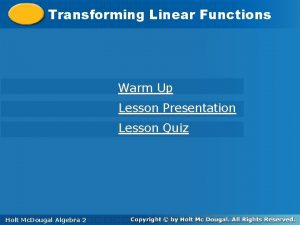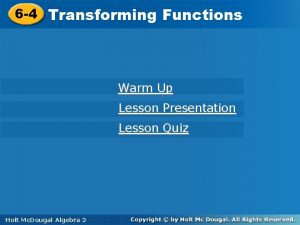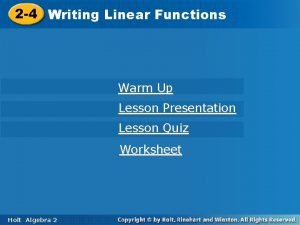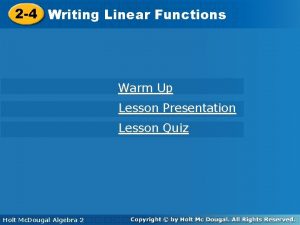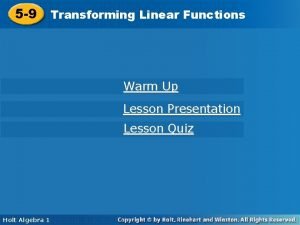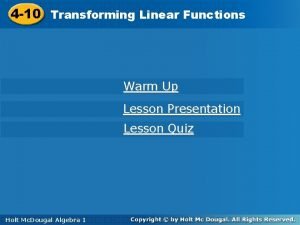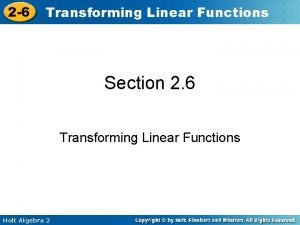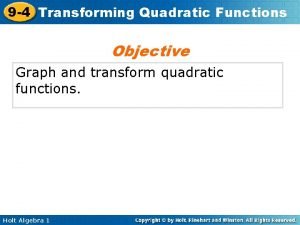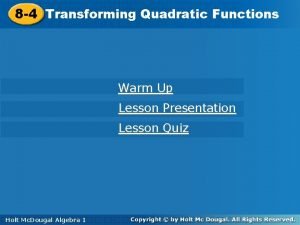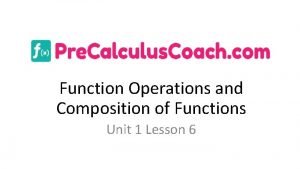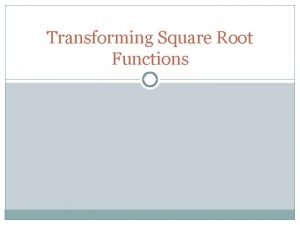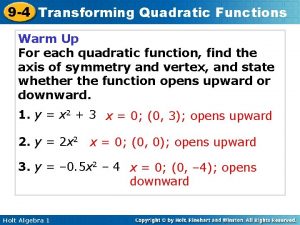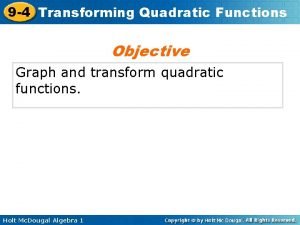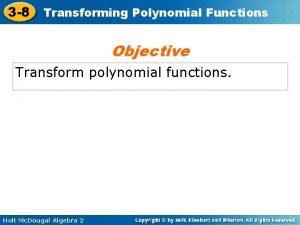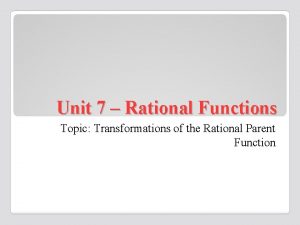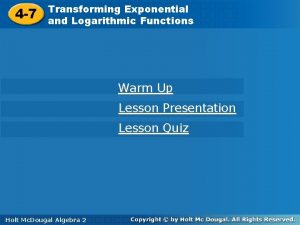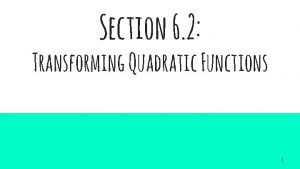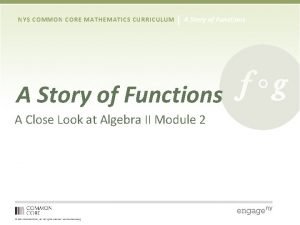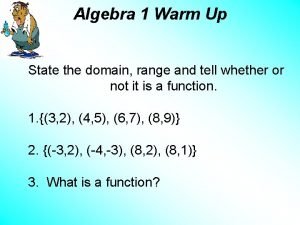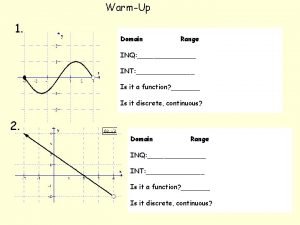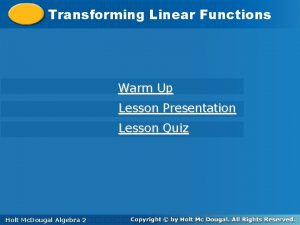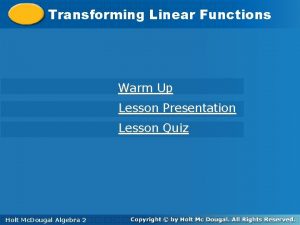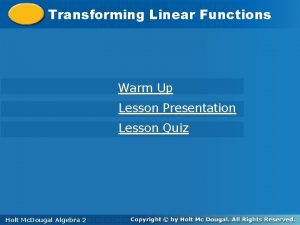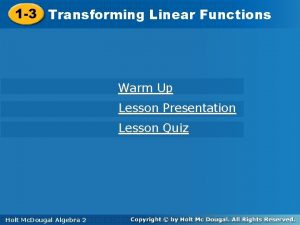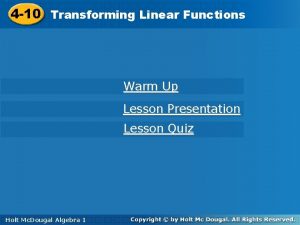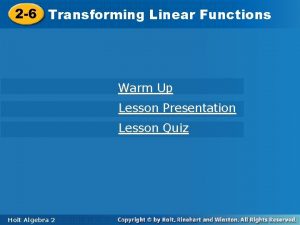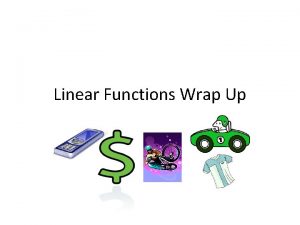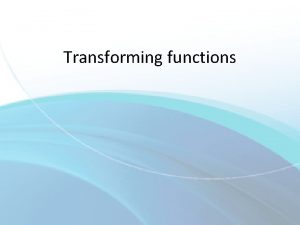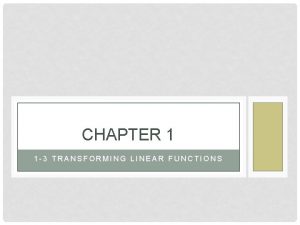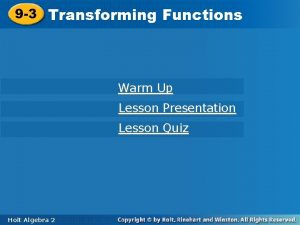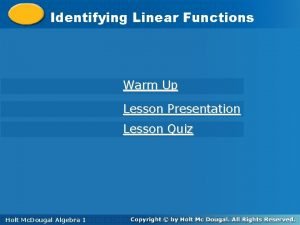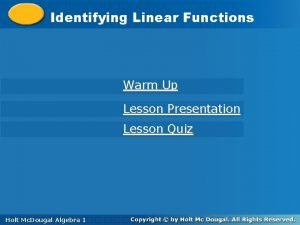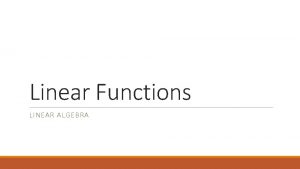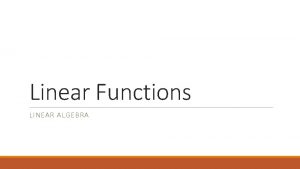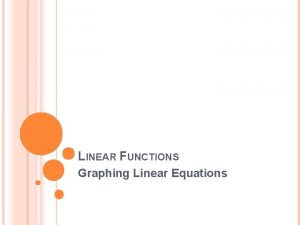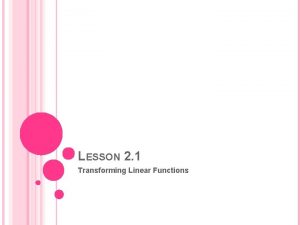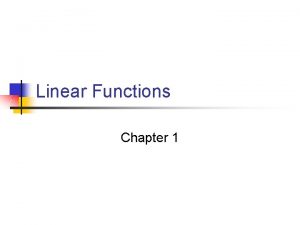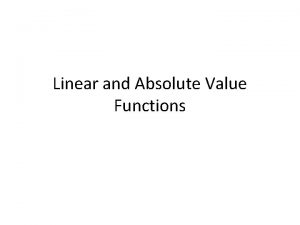5 9 Transforming Linear Functions Warm Up Lesson


























- Slides: 26

5 -9 Transforming. Linear. Functions Warm Up Lesson Presentation Lesson Quiz Holt Algebra 1

5 -9 Transforming Linear Functions Warm Up Identifying slope and y-intercept. 1. y = x + 4 m = 1; b = 4 2. y = – 3 x m = – 3; b = 0 Compare and contrast the graphs of each pair of equations. 3. y = 2 x + 4 and y = 2 x – 4 same slope, parallel, and different intercepts 4. y = 2 x + 4 and y = – 2 x + 4 same y-intercepts; different slopes but same steepness Holt Algebra 1

5 -9 Transforming Linear Functions Objective Describe how changing slope and y-intercept affect the graph of a linear function. Holt Algebra 1

5 -9 Transforming Linear Functions Vocabulary family of functions parent function transformation translation rotation reflection Holt Algebra 1

5 -9 Transforming Linear Functions A family of functions is a set of functions whose graphs have basic characteristics in common. For example, all linear functions form a family because all of their graphs are the same basic shape. A parent function is the most basic function in a family. For linear functions, the parent function is f(x) = x. The graphs of all other linear functions are transformations of the graph of the parent function, f(x) = x. A transformation is a change in position or size of a figure. Holt Algebra 1

5 -9 Transforming Linear Functions There are three types of transformations– translations, rotations, and reflections. Look at the four functions and their graphs below. Holt Algebra 1

5 -9 Transforming Linear Functions Notice that all of the lines are parallel. The slopes are the same but the y-intercepts are different. Holt Algebra 1

5 -9 Transforming Linear Functions The graphs of g(x) = x + 3, h(x) = x – 2, and k(x) = x – 4, are vertical translations of the graph of the parent function, f(x) = x. A translation is a type of transformation that moves every point the same distance in the same direction. You can think of a translation as a “slide. ” Holt Algebra 1

5 -9 Transforming Linear Functions Holt Algebra 1

5 -9 Transforming Linear Functions Example 1: Translating Linear Functions Graph f(x) = 2 x and g(x) = 2 x – 6. Then describe the transformation from the graph of f(x) to the graph of g(x). f(x) = 2 x g(x) = 2 x – 6 g(x) = 2 x − 6 The graph of g(x) = 2 x – 6 is the result of translating the graph of f(x) = 2 x 6 units down. Holt Algebra 1

5 -9 Transforming Linear Functions Check It Out! Example 1 Graph f(x) = x + 4 and g(x) = x – 2. Then describe the transformation from the graph of f(x) to the graph of g(x). f(x) = x + 4 g(x) = x − 2 g(x) = x – 2 The graph of g(x) = x – 2 is the result of translating the graph of f(x) = x + 4 6 units down. Holt Algebra 1

5 -9 Transforming Linear Functions The graphs of g(x) = 3 x, h(x) = 5 x, and k(x) = are rotations of the graph f(x) = x. A rotation is a transformation about a point. You can think of a rotation as a “turn. ” The y -intercepts are the same, but the slopes are different. Holt Algebra 1

5 -9 Transforming Linear Functions Holt Algebra 1

5 -9 Transforming Linear Functions Example 2: Rotating Linear Functions Graph f(x) = x and g(x) = 5 x. Then describe the transformation from the graph of f(x) to the graph of g(x). f(x) = x g(x) = 5 x The graph of g(x) = 5 x is the result of rotating the graph of f(x) = x about (0, 0). The graph of g(x) is steeper than the graph of f(x). Holt Algebra 1

5 -9 Transforming Linear Functions Check It Out! Example 2 Graph f(x) = 3 x – 1 and g(x) = x – 1. Then describe the transformation from the graph of f(x) to the graph of g(x). f(x) = 3 x – 1 g(x) = f(x) = 3 x – 1 x– 1 g(x) = x– 1 The graph of g(x) is the result of rotating the graph of f(x) about (0, – 1). The graph of g(x) is less steep than the graph of f(x). Holt Algebra 1

5 -9 Transforming Linear Functions The diagram shows the reflection of the graph of f(x) = 2 x across the y-axis, producing the graph of g(x) = – 2 x. A reflection is a transformation across a line that produces a mirror image. You can think of a reflection as a “flip” over a line. Holt Algebra 1

5 -9 Transforming Linear Functions Holt Algebra 1

5 -9 Transforming Linear Functions Example 3: Reflecting Linear Functions Graph f(x) = 2 x + 2. Then reflect the graph of f(x) across the y-axis. Write a function g(x) to describe the new graph. f(x) = 2 x + 2 g(x) f(x) To find g(x), multiply the value of m by – 1. In f(x) = 2 x + 2, m = 2. 2(– 1) = – 2 This is the value of m for g(x) = – 2 x + 2 Holt Algebra 1

5 -9 Transforming Linear Functions Check It Out! Example 3 Graph. Then reflect the graph of f(x) across the y-axis. Write a function g(x) to describe the new graph. f(x) g(x) To find g(x), multiply the value of m by – 1. In f(x) = x + 2, m =. (– 1) = – This is the value of m for g(x) = – x + 2 Holt Algebra 1

5 -9 Transforming Linear Functions Example 4: Multiple Transformations of Linear Functions Graph f(x) = x and g(x) = 2 x – 3. Then describe the transformations from the graph of f(x) to the graph of g(x). Find transformations of f(x) = x that will result in g(x) = 2 x – 3: h(x) = 2 x • Multiply f(x) by 2 to get h(x) = 2 x. This rotates the graph about (0, 0) and makes it parallel to f(x) = x g(x). • Then subtract 3 from h(x) to get g(x) = 2 x – 3. This translates the graph 3 units down. The transformations are a rotation and a translation. Holt Algebra 1

5 -9 Transforming Linear Functions Check It Out! Example 4 Graph f(x) = x and g(x) = –x + 2. Then describe the transformations from the graph of f(x) to the graph of g(x). Find transformations of f(x) = x that will result in g(x) = –x + 2: • Multiply f(x) by – 1 to get h(x) = –x. This reflects the graph across the y-axis. g(x) = –x + 2 h(x) = –x f(x) = x • Then add 2 to h(x) to get g(x) = –x + 2. This translates the graph 2 units up. The transformations are a reflection and a translation. Holt Algebra 1

5 -9 Transforming Linear Functions Example 5: Business Application A florist charges $25 for a vase plus $4. 50 for each flower. The total charge for the vase and flowers is given by the function f(x) = 4. 50 x + 25. How will the graph change if the vase’s cost is raised to $35? if the charge per flower is Total Cost lowered to $3. 00? f(x) = 4. 50 x + 25 is graphed in blue. If the vase’s price is raised to $35, the new function is f(g) = 4. 50 x + 35. The original graph will be translated 10 units up. Holt Algebra 1

5 -9 Transforming Linear Functions Example 5 Continued A florist charges $25 for a vase plus $4. 50 for each flower. The total charge for the vase and flowers is given by the function f(x) = 4. 50 x + 25. How will the graph change if the vase’s cost is raised to $35? If the charge per flower is Total Cost lowered to $3. 00? If the charge per flower is lowered to $3. 00. The new function is h(x) = 3. 00 x + 25. The original graph will be rotated clockwise about (0, 25) and become less steep. Holt Algebra 1

5 -9 Transforming Linear Functions Check It Out! Example 5 What if…? How will the graph change if the charge per letter is lowered to $0. 15? If the trophy’s cost is raised to $180? f(x) = 0. 20 x + 175 is If the charge per trophy is graphed in blue. raised to $180. The new If the cost function is per h(x)letter = 0. 20 x + charged lowered to will 180. Theisoriginal graph $0. 15, the new function be translated 5 units up. is g(x) = 0. 15 x + 175. The original graph will be rotated around (0, 175) and become less steep. Holt Algebra 1 Cost of Trophy

5 -9 Transforming Linear Functions Lesson Quiz: Part I Describe the transformation from the graph of f(x) to the graph of g(x). 1. f(x) = 4 x, g(x) = x rotated about (0, 0) (less steep) 2. f(x) = x – 1, g(x) = x + 6 translated 7 units up 3. f(x) = x, g(x) = 2 x rotated about (0, 0) (steeper) 4. f(x) = 5 x, g(x) = – 5 x reflected across the y-axis, rot. about (0, 0) Holt Algebra 1

5 -9 Transforming Linear Functions Lesson Quiz: Part II 5. f(x) = x, g(x) = x – 4 translated 4 units down 6. f(x) = – 3 x, g(x) = –x + 1 rotated about (0, 0) (less steep), translated 1 unit up 7. A cashier gets a $50 bonus for working on a holiday plus $9/h. The total holiday salary is given by the function f(x) = 9 x + 50. How will the graph change if the bonus is raised to $75? if the hourly rate is raised to $12/h? translate 25 units up; rotated about (0, 50) (steeper) Holt Algebra 1
 How to stretch a linear function
How to stretch a linear function Lesson 6-4 transforming linear functions
Lesson 6-4 transforming linear functions Lesson 4-10 transforming linear functions answers
Lesson 4-10 transforming linear functions answers 2-4 writing linear equations answer key
2-4 writing linear equations answer key 3-3 lesson quiz transforming linear functions
3-3 lesson quiz transforming linear functions Linear function transformations
Linear function transformations Transforming linear functions lesson 6-4
Transforming linear functions lesson 6-4 Horizontal compression linear function
Horizontal compression linear function 6-4 transforming linear functions
6-4 transforming linear functions 9-4 practice b transforming quadratic functions
9-4 practice b transforming quadratic functions Transforming polynomial functions quiz part 1
Transforming polynomial functions quiz part 1 Transforming quadratic functions
Transforming quadratic functions Perform function operations and composition
Perform function operations and composition Vertical answer
Vertical answer 9-4 transforming quadratic functions
9-4 transforming quadratic functions Example of narrowest graph
Example of narrowest graph Transformations polynomial functions
Transformations polynomial functions Rational function parent function
Rational function parent function Transforming exponential and logarithmic functions
Transforming exponential and logarithmic functions Transforming quadratic functions
Transforming quadratic functions Lesson 4 from circle-ometry to trigonometry
Lesson 4 from circle-ometry to trigonometry Warm up domain range and functions
Warm up domain range and functions Warm up domain range and functions
Warm up domain range and functions Linear regression vs multiple regression
Linear regression vs multiple regression Contoh soal persamaan non linear dengan metode biseksi
Contoh soal persamaan non linear dengan metode biseksi Types of linear text
Types of linear text Examples of non linear plot
Examples of non linear plot
